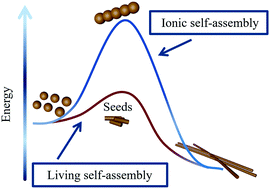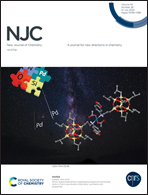Morphological transformation of ultrasonically obtained nanofibers during living self-assembly†
Abstract
In this work, we demonstrate the fabrication of organic/inorganic hybrid materials based on living self-assembly. First, polyoxometalate (Keggin-type phosphotungstic acid, H3PW12O40) (POM) as an inorganic constituent and surface active ionic liquid (1-dodecyl-3-carboxymethyl imidazolium bromide, [N-C12, N′-COOH-Im]Br) (SAIL) as an organic constituent, were utilized to construct organic/inorganic hybrid nanofibers via an ionic self-assembly approach. The time-dependent evolution of the morphology from nanoparticles to nanofibers was investigated using various techniques (e.g. SEM, TEM, and UV/Vis). Hydrogen bonds and hydrophobic interactions were proved to play a dominant role in the evolution process. Next, of particular interest, POM/[N-C12, N′-COOH-Im]Br hybrid nanofibers were also obtained via a living self-assembly process by mixing metastable nanoparticle building blocks and seeds generated via ultrasonication of nanofibers. It is observed that the metastable nanoparticles directly bound to the end of the seeds, resulting in the formation of nanofibers. This strategy reduces the morphological evolution time from 7 days to 24 h, which suggests that the introduction of seeds greatly lowers the energy barrier in the morphological evolution process. Our study indicates that organic/inorganic hybrid materials can be obtained via living self-assembly. This will facilitate the use of functional organic/inorganic hybrid materials in various applications. Furthermore, this study represents an important step toward artificial systems that can mimic biological systems.



 Please wait while we load your content...
Please wait while we load your content...